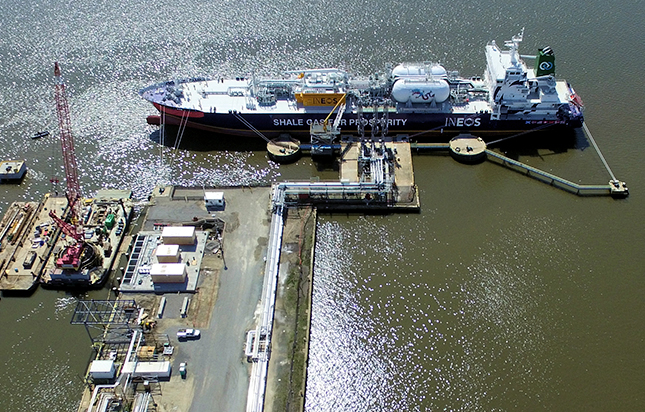

An Opportunity for Growth
When Marcus Hook Refinery shifted their operations to become Marcus Hook Industrial Complex, they needed a routine dock inspection to determine whether the existing dock could accommodate a new LPG tanker vessel. They hired S. T. Hudson, and once the project was underway, it evolved into a complete dock upgrade that included new breasting dolphins, fender systems, mooring systems, marine loading arms, gangway system, a jib crane, and a dock house operation center.

Project Goals
Converting the facility to an entirely new system was an ambitious venture. It was imperative to complete all the necessary steps with precision to ensure the outcome would be a success. As such, the goals for this project were to:
Assess Facility Needs
A thorough and complete dock inspection was necessary to understand the scope of the project.
Provide Complete Structural Design Services
From FEED to construction, the S. T. Hudson team provided Marcus Hook Industrial Complex with the resources they needed to transition their facilities.
Overhaul Existing Structures
Switching from petroleum product storage to a liquified gas storage center required both demolition and installation of new dock structures, piping, marine loading arms, and firefighting system.
Enable a Lucrative Business Opportunity
With economic uncertainty and fluctuations in demand for petroleum products, exploring a new sector would create stability and an influx of new jobs for the area.
Key Data Points
1,196
sq ft
Loading
Platform
2
New
Breasting
Dolphins
4
New Triple
Quick-Release
Hooks
5
New
Fender
Systems
920
sq ft Sump Containment Area With Pump
1
New
Jib Crane
for Hose Handling
Project Details
What began as a dock inspection turned into a major overhaul of various dock structures to prepare for a new fleet of ocean-going ships. This EPC project led by S. T. Hudson included a large demolition of current structures, the design and installation of an entirely new pipe rack system, new cryogenic marine loading arms, and more.
Once a refinery, Marcus Hook Industrial Complex was transformed into a bustling storage and export center for liquified gases. It was built in 1902 and started out with the processing of light sweet crude oil from Texas, eventually transitioning to become highly advanced in the field for petroleum production. In 2012, the company was acquired by Sunoco Logistics, who merged with Energy Transfer in 2017. They saw an opportunity for advancement and decided to repurpose the refinery complex for building and storing cryogenic tanks to repurpose the refinery complex for storing and exporting liquified petroleum gas, requiring the building of new dock facilities and cryogenic tanks.
The project involved taking the existing docks that typically handle petrochemical products and converting them to a liquified gas export center for a new fleet of ships carrying natural gas liquids across the ocean. Using Optimoor software, a standard for international shipping agents, S. T. Hudson performed an analysis of the current state of the platforms — allowing them to calculate the forces ships would put on a dock. From here, the team was able to determine the structural designs necessary to safely moor the ship to the berth for safe loading and unloading of product.
S.T. Hudson served an EPC role in this project. Not only did we provide full design services, we were also the general contractor responsible for complete construction of the project. This project allowed us to showcase the full breadth of our capabilities; from marine and mechanical engineering hydrographic and dive services to estimating, purchasing, and construction services. In the end, the project was a complete success, giving Energy Transfer the ability to bring in new ships and commence the exportation of liquified gases, a move that created many new jobs for the area.
Project Highlights
The complete scope of work for this project included:
- Dock inspection, including:
- Optimoor mooring analysis
- PIANC berthing analysis
- Structural assessments
- Recommendations with costs
- Structural design from FEED to construction
- Construction management services including all purchasing and construction support functions
- Demolition of prior structures
- Installation of:
- New pipe track system
- New cryogenic marine loading arms
- New firefighting system









